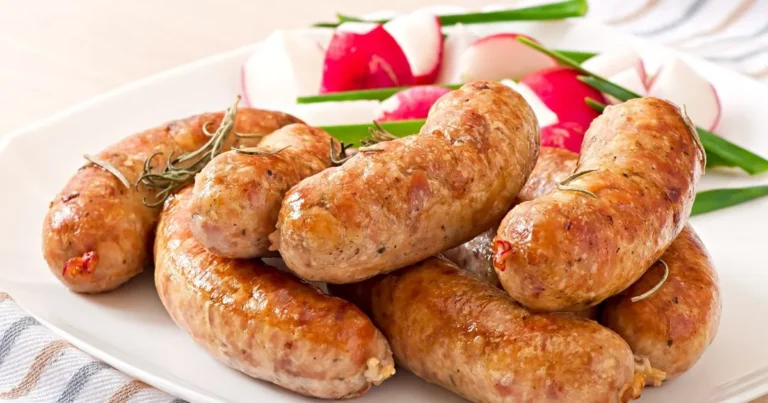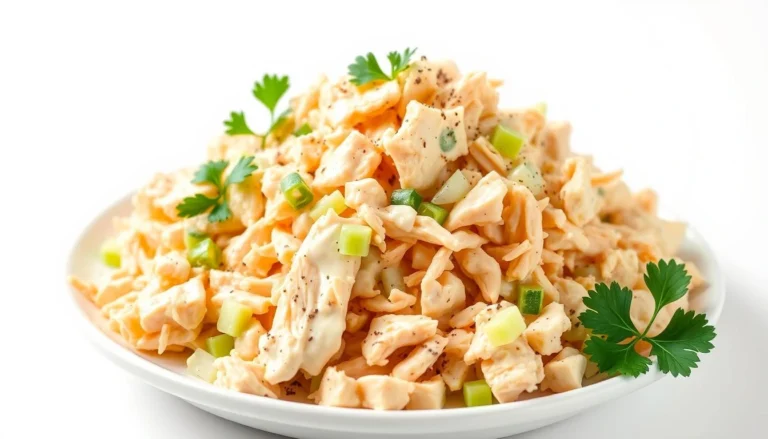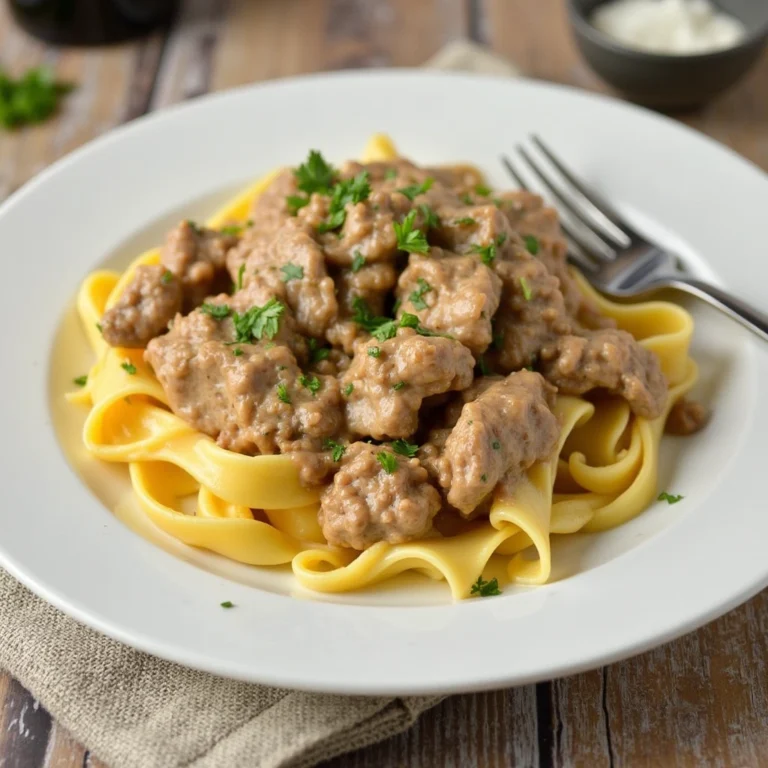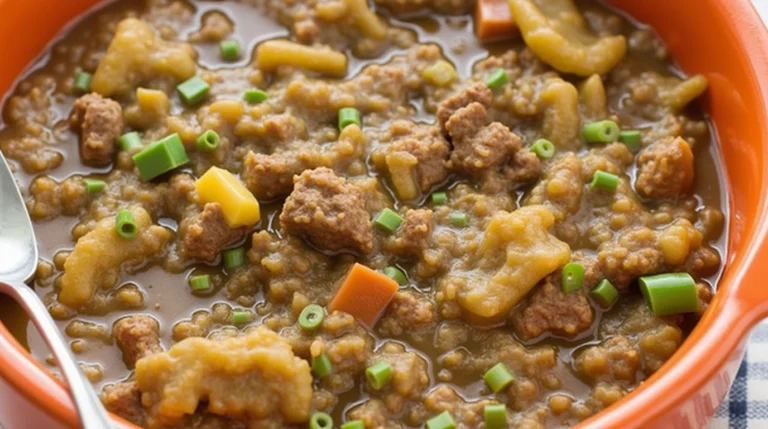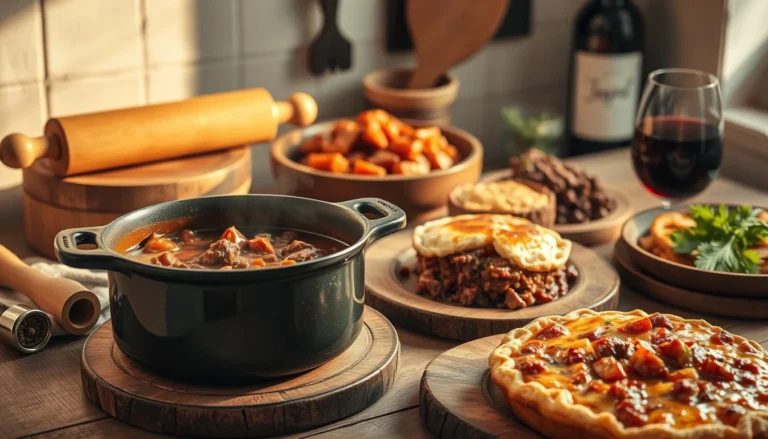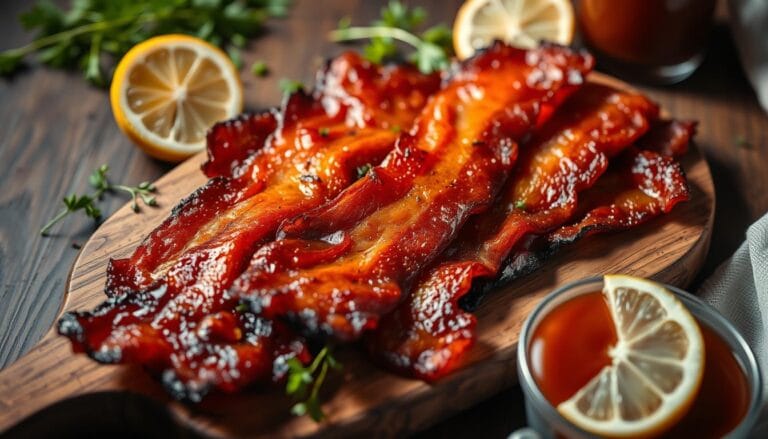Cooking a Turkey in a Roaster: Step-by-Step Guide
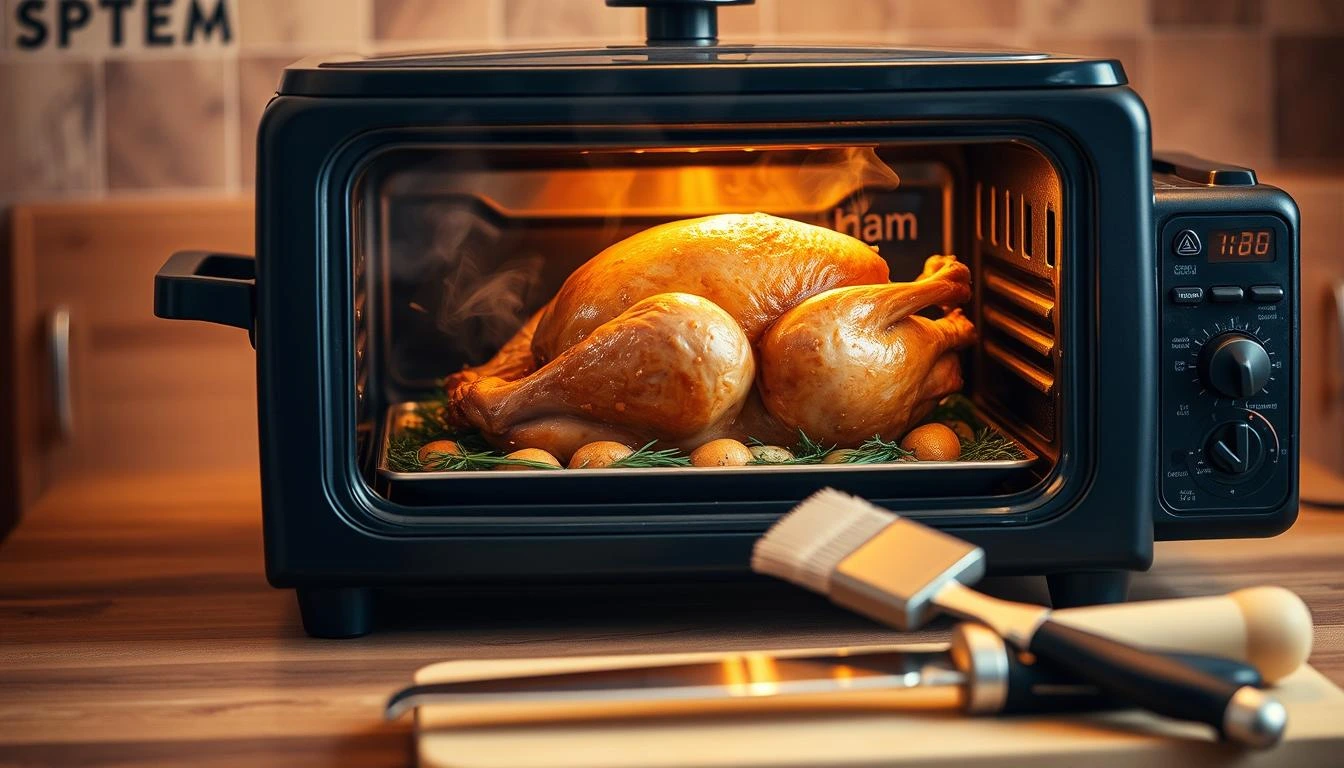
Table of Contents
Cooking a Turkey in a Roaster brings back cherished memories of Thanksgiving with my grandmother. She taught me how to use a roaster oven, and the incredible aroma that filled the kitchen made our family gatherings feel magical.
Using a roaster oven isn’t just a cooking method—it’s a holiday game-changer. It frees up your main oven for side dishes and desserts, simplifies preparation, and delivers juicy, evenly cooked turkey every time.
Electric roasters are energy-efficient and easy to use, making Thanksgiving dinner less stressful and more enjoyable.
Key Takeaways
- Roaster ovens simplify turkey preparation
- Electric roasters ensure even cooking
- Frees up conventional oven space
- Ideal for consistent, juicy turkey results
- Reduces overall cooking complexity
Benefits of Cooking a Turkey in a Roaster
Getting a delicious roasted turkey recipe right needs the right tools. A roaster brings many benefits that can change how you make your holiday meals. These kitchen helpers are a big plus for anyone wanting to make cooking turkey easier.
Even Cooking and Juiciness
The best roaster for turkey makes sure your turkey is always perfectly cooked. Roaster ovens have a special lid that spreads heat evenly. This keeps the turkey moist, making the meat tender and juicy.
Your white meat won’t dry out, a big problem with traditional ovens.
Time Efficiency
Cooking a turkey can take a lot of time, but a good roaster makes it faster. These appliances cook quicker than regular ovens, perfect for those who are always busy. You’ll save time and energy, which is great during the holidays.
- Faster cooking times
- More even heat distribution
- Lower energy consumption
Easy Cleanup
Another big plus of using a roaster is how easy it is to clean up. Modern roasters have non-stick surfaces and parts that are easy to remove. This means you spend less time cleaning and more time enjoying your turkey with loved ones.
Pro tip: Look for roasters with dishwasher-safe components to make cleanup even easier!
Choosing the Right Roaster
Choosing the best roaster for cooking turkey is key to a great holiday meal. The roaster you pick affects cooking time, flavor, and texture.
When roasting a turkey in an electric roaster, consider a few important factors for perfect results.
Electric vs. Traditional Roasters
Electric roasters have some big advantages over traditional ovens:
- They keep the temperature steady
- They save oven space for side dishes
- They use less energy
- They’re easier to clean
Size Considerations
Choosing the right size roaster is important. Here are some guidelines:
- Small roasters (12-16 quarts): Good for turkeys up to 14 pounds
- Medium roasters (16-18 quarts): Ideal for 14-20 pound turkeys
- Large roasters (18-22 quarts): Best for 20-24 pound turkeys
Features to Look For
When looking for the best roaster for turkey, focus on these features:
- Adjustable temperature settings
- Removable rack for easy turkey placement
- Self-basting lid
- Warm setting to keep food warm
The Oster 18-quart roaster oven is a top choice. It fits turkeys up to 22 pounds and has useful features.
Pro tip: Always measure your turkey and roaster before buying to ensure a perfect fit!
Preparing the Turkey for Roasting
Getting your turkey ready for the roaster oven is key. A good step-by-step guide starts with careful preparation. This ensures your turkey is both tasty and safe for your family.
Thawing the Turkey Safely
Thawing a frozen turkey is essential for safety. Here’s how to thaw your turkey for the roaster oven recipe:
- Thaw turkey in the fridge, taking 24 hours for every 4-5 pounds
- Don’t thaw turkey at room temperature
- Keep it in its original packaging while thawing
- Use a tray to catch any drips
Cleaning and Drying the Bird
Cleaning the turkey is the first step to a great roast. Remove the neck and giblets from the cavity. Dry the turkey with paper towels for crispy skin and better browning.
Seasoning Options
Make a tasty herb butter for your turkey:
- Mix softened butter with fresh herbs like sage, rosemary, and thyme
- Separate the skin from the meat gently
- Spread the herb butter under the skin
- Season the outside with salt and pepper
Pro tip: Let the seasoned turkey sit for 30 minutes before roasting. This helps the flavors soak in better.
Stuffing vs. Unstuffed Turkey
Deciding whether to stuff your turkey or not is key when cooking on a roaster. This choice affects your cooking process and the turkey’s flavor.
Stuffing a turkey can make it taste better. But, it also has its downsides. Knowing the pros and cons of stuffing is important for a juicy turkey.
Pros and Cons of Stuffing
- Pros:
- Adds rich flavor to the turkey
- Creates a traditional holiday experience
- Infuses moisture into the meat
- Cons:
- Increases risk of bacterial growth
- Can lead to uneven cooking
- Potentially longer cooking time
Alternative Stuffing Ideas
Try these tasty alternatives to traditional stuffing for your turkey:
- Aromatic vegetable mix (celery, onions, carrots)
- Citrus fruits like lemons and oranges
- Fresh herbs (rosemary, thyme, sage)
- Whole garlic cloves
“The secret to a perfect roasted turkey is not just in the stuffing, but in how you prepare and cook it.”
Cooking Time Differences
Stuffed turkeys need more cooking time. The roaster’s temperature and stuffing amount affect cooking time. Always check the turkey’s internal temperature with a meat thermometer. It should reach 165°F, stuffed or unstuffed.
Preheating Your Roaster
Preheating your electric roaster is a key step for roasting a turkey. It makes sure your turkey cooks evenly and gets that golden-brown skin everyone wants. The right temperature is essential for perfect results.
Here are the important steps for preheating your roaster:
- Set your roaster to its highest temperature setting
- Typical maximum temperatures range between 400-450°F
- Allow the roaster to fully preheat for 15-20 minutes
The cooking time for a turkey depends on how well you preheat. Most electric roasters can get up to 450°F. This helps make the outside crispy and keeps the inside juicy. Always check your roaster’s manual for the best temperature.
Pro tip: A well-preheated roaster reduces overall cooking time and helps seal in the turkey’s natural juices.
Make sure you know what your roaster can do. Some models might have different max temperatures. Always follow the manufacturer’s instructions for the best settings.
- Quick check: Verify the roaster is fully heated before placing your turkey inside
- Temperature matters: Consistent heat is crucial for even cooking
How to Set Up the Roaster
Learning to cook a turkey on a roaster starts with setting it up right. Your guide to roasting a turkey is all about preparation and placement.

Getting your roaster ready is all about the details. Make sure you have everything you need before putting the turkey in.
Positioning Your Turkey Perfectly
Put your turkey on the roasting rack with care. Follow these steps:
- Center the turkey in the roaster
- Ensure the bird is breast-side up
- Allow space around the turkey for air circulation
- Position the rack to keep the turkey elevated
Enhancing Flavor with Aromatics
Make your turkey special with aromatic ingredients. Try these:
- Fresh herbs like rosemary, thyme, and sage
- Citrus fruits such as lemon or orange wedges
- Whole garlic cloves
- Quartered onions
Put aromatics inside the turkey and around the pan. They’ll add amazing flavors to your turkey while it cooks.
Cooking Times Based on Turkey Weight
Learning the right cooking times for roasting a turkey is essential for a great holiday meal. Knowing the turkey roasting temperature guidelines is key to a perfectly cooked bird. It must be both safe and delicious.
The turkey’s cooking time depends on several important factors. The bird’s weight is a major factor in determining the cooking time.
General Cooking Time Guidelines
For an unstuffed turkey, follow these general recommendations:
- 4-6 pounds: About 1.5-2 hours
- 6-8 pounds: Around 2-3 hours
- 8-12 pounds: Approximately 2.5-3 hours
- 12-16 pounds: About 3-4 hours
- 16-20 pounds: Roughly 4-5 hours
Using a Meat Thermometer
A meat thermometer is your best friend when roasting a turkey. Always check the internal temperature to ensure food safety. The turkey is done when the thickest part of the thigh reaches 165°F.
Factors Affecting Cooking Time
Several elements can impact your turkey’s cooking time:
- Starting temperature of the turkey
- Accuracy of your roaster’s temperature
- Whether the turkey is stuffed or unstuffed
- Oven or roaster calibration
Pro tip: Let your turkey rest for 20-30 minutes after cooking to allow juices to redistribute, ensuring a moist and flavorful meal.
Remember, patience is key when roasting a turkey. Rushing the process can lead to an undercooked or dry bird. Always prioritize food safety and use a reliable meat thermometer to guide your cooking.
Basting Techniques for a Juicy Turkey
Learning to make a tasty roasted turkey recipe means knowing special basting tricks. Electric roasters change the game by keeping your turkey moist without old-school basting.
When you’re making a juicy turkey in a roaster, the cooking method itself keeps it moist. The roaster’s design makes a steamy environment. This naturally bastes the turkey, so you don’t need to keep adding liquid.
Understanding Roaster Moisture Retention
Electric roasters are different from regular ovens. Their sealed lid traps steam, which moves around the turkey. This ensures:
- Consistent moisture throughout cooking
- Even heat distribution
- Minimal manual intervention
Optional Basting Techniques
If you want more flavor, try these light basting ideas:
- Use melted butter for a rich golden skin
- Try herb-infused olive oil
- Apply a light broth mixture sparingly
“The secret to a perfect turkey is understanding your cooking method’s unique characteristics.” – Professional Chef
With an electric roaster, less is often more when it comes to basting your turkey.
Achieving Golden Brown Skin

Getting your roaster oven turkey to have golden-brown skin can be tough. Roaster ovens often don’t make the outside as crispy as traditional ovens. But, there are some great tips to help you get that perfect browned bird.
Start by preheating your roaster to the highest temperature. A quick blast of high heat helps crisp the skin in the first 30 minutes. This kickstarts the browning and makes your turkey look great.
- Rub the turkey with olive oil or melted butter before cooking
- Use a commercial browning sauce for added color
- Pat the skin completely dry before seasoning
- Remove the lid during the last 30 minutes of cooking
Want an extra trick? Try using a browning sauce. These sauces can give your turkey a rich, golden color. Just remember, a little goes a long way to keep the turkey’s flavor.
Pro tip: For the most even browning, rotate your turkey halfway through cooking and baste with its own juices.
Getting golden brown skin in a roaster might take some extra work. But, the taste is just as good as a traditional oven-roasted turkey. Your guests will be impressed!
Knowing When Your Turkey is Done
Finding the right time to take your turkey out of the oven can be hard. Knowing the turkey roasting temperature is key for both safety and taste. It’s important to watch it closely when cooking a turkey on a roaster.
Checking if your turkey is done isn’t just about how it looks. The best way is to use a meat thermometer to check the inside temperature.
Internal Temperature Guidelines
Here are the turkey roasting temperature guidelines to make sure your meal is safe and tasty:
- Insert the meat thermometer into the thickest part of the thigh
- Aim for an internal temperature of 165°F
- Some chefs prefer cooking to 170°F for extra tenderness
Signs of Doneness to Watch For
Look for these signs to know if your turkey is done:
- Clear juices running from the turkey
- Leg joints move easily when wiggled
- Golden brown skin with crispy texture
Pro tip: Always let your turkey rest for 15-20 minutes after removing from the roaster to allow juices to redistribute.
Remember, patience and a reliable meat thermometer are your best tools for achieving the perfect roasted turkey.
Resting Your Turkey After Roasting
After roasting your turkey, the last step is letting it rest. This step is key to making your meal unforgettable. Resting your turkey can turn a good meal into a great one.
When you take the turkey out of the oven, it keeps cooking. This is when the meat changes in important ways. Resting helps the juices spread out, making each slice juicy and full of flavor.
The Science Behind Resting
Roasting makes the turkey’s muscles tight, pushing juices to the center. Resting lets these muscles relax. This way, juices can spread out evenly:
- Prevents dry, tough meat
- Enhances overall flavor
- Improves carving consistency
Recommended Resting Duration
The right resting time depends on your turkey’s size:
- Small turkeys (8-12 pounds): 20-30 minutes
- Medium turkeys (15-18 pounds): 30-40 minutes
- Large turkeys (20+ pounds): 45-60 minutes
Cover your turkey with foil to keep it warm while it rests. This way, your turkey stays perfectly succulent.
Carving Your Roast Turkey
After you’ve perfected your roasted turkey recipe, it’s time to learn how to carve it like a pro. A well-carved turkey looks great and makes sure each guest gets the best slice. This is the final step of your step by step turkey roasting guide.
Best Tools for Carving
To carve your turkey well, you need the right tools:
- A sharp carving knife with a long, thin blade
- A sturdy carving fork to hold the turkey steady
- A large cutting board with a juice groove
- Clean kitchen towels for handling
Step-by-Step Carving Instructions
- Let the turkey rest for 20-30 minutes after roasting
- Place the turkey breast-side up on the cutting board
- Remove the legs by cutting through the hip joint
- Separate the thighs from the drumsticks
- Slice breast meat against the grain in smooth, even cuts
- Arrange meat on a serving platter
Pro tip: Always cut slowly and use a sharp knife. This keeps the turkey moist and looks great.
Serving and Storing Leftover Turkey
After enjoying your delicious roasted turkey recipe, you’ll want to make the most of every delectable bite. Leftover turkey from your roaster oven turkey recipe can be transformed into exciting new meals. These meals will keep your family excited about the feast.
Smart storage is key to maintaining your turkey’s flavor and safety. Here are some essential tips for handling leftover turkey:
Creative Leftover Solutions
- Turkey sandwiches with cranberry spread
- Hearty turkey pot pie
- Zesty turkey enchiladas
- Comforting turkey noodle soup
- Turkey salad for quick lunches
Proper Storage Techniques
To keep your roasted turkey fresh and tasty, follow these storage guidelines:
- Remove meat from bones within two hours of cooking
- Store in airtight containers
- Refrigerate for up to 3-4 days
- Freeze in sealed containers for up to 4 months
Reheating Tips
When reheating your leftover turkey, use these methods to preserve moisture:
- Microwave with a splash of broth
- Oven method: Cover and heat at 300°F
- Add a little chicken stock to prevent drying
Pro tip: Always ensure your leftover turkey reaches an internal temperature of 165°F when reheating to guarantee food safety.
safety.
Conclusion and Final Tips for Roasting Turkey
Roasting a turkey in an electric roaster can make your holiday meal amazing. It’s not hard to learn how to do it. With some practice, you’ll make a turkey that everyone will love.
The secret to a great turkey is knowing the basics. This includes preparing the turkey right, seasoning it well, keeping an eye on the temperature, and letting it rest. To get a juicy turkey, keep the temperature steady, use a meat thermometer, and don’t over-baste. This keeps the skin crispy.
Embracing Your Culinary Adv
Conclusion and Final Tips for Roasting Turkey
Roasting a turkey in an electric roaster can make your holiday meal amazing. It’s not hard to learn how to do it. With some practice, you’ll make a turkey that everyone will love.
The secret to a great turkey is knowing the basics. This includes preparing the turkey right, seasoning it well, keeping an eye on the temperature, and letting it rest. To get a juicy turkey, keep the temperature steady, use a meat thermometer, and don’t over-baste. This keeps the skin crispy.
Embracing Your Culinary Adventure
Don’t worry if your first turkey isn’t perfect. Every good cook started somewhere. Electric roasters are easy to use and help keep the turkey moist. Remember, the more you practice, the better you’ll get.
Your Next Delicious Step
Start your journey to becoming a great cook. An electric roaster is a great tool for making meals that everyone will enjoy. With patience and practice, you’ll soon be making turkeys that everyone will talk about.
FAQ
What size roaster do I need for a turkey?
How long does it take to cook a turkey in a roaster oven?
Do I need to thaw my turkey before cooking in a roaster?
Can I stuff a turkey when using a roaster oven?
How do I keep my roaster turkey skin crispy?
Do I need to baste the turkey in a roaster oven?
What’s the best way to store leftover roaster turkey?
Can I use a roaster oven for other dishes besides turkey?
There are no reviews yet. Be the first one to write one.

